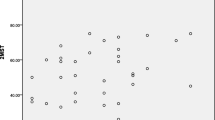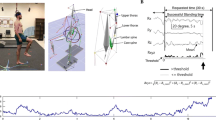Abstract
Objective
This study examines the test–retest reliability, the minimal clinically important difference (MCID), and its correlation with the Rolland Morris Disability Questionnaire (RMDQ) of the Dubousset Functional Test (DFT) in evaluating the functional capacity and dynamic balance of patients with chronic non-specific low back pain (cnsLBP).
Methods
Seventy-five patients with cnsLBP aged 18 years and over were included. The Five-Repetition Sit-To-Stand Test (5R-STS), the subcomponents of the DFT (the Up and Walk Test, the Steps Test, the Down and Sitting Test, and the Dual-Tasking Test) were administered to the patients. Patients were rested for 1 h, and the DFT was applied again. Pain level was evaluated with the Visual Analogue Scale before the tests started and after the tests were completed. Self-report function assessment was made using the RMDQ.
Results
The test–retest reliability of the subcomponents of the DFT was excellent. The ICCs were: 0.91, 0.86, 0.89, and 0.89, respectively. The standard measurement errors of the subcomponents of the DFT were 0.32, 0.12, 0.14, and 0.25, respectively. The subcomponents of the DFT were highly correlated with the RMDQ and 5R-STS with the correlation coefficients of 0,83, 0,83, 0,79, 0,83 and 0,81, 0,75, 0,73, and 0,82, respectively (p < 0.01). The MCIDs of the subcomponents were 0,60, 0,23, 0,27, and 0,48, respectively.
Conclusion
The DFT is reliable in evaluating patients’ functional capacity and dynamic balance with cnsLBP without causing discomfort. It is simple, quick, and simultaneously assesses multiple areas contributing to spinal alignment, muscle integrity, and balance.


Similar content being viewed by others
References
Koes BW, van Tulder MW, Thomas S (2006) Diagnosis and treatment of low back pain. BMJ 332:1430–1434. https://doi.org/10.1136/bmj.332.7555.1430
Chiarotto A, Boers M, Deyo RA et al (2018) Core outcome measurement instruments for clinical trials in nonspecific low back pain. Pain 159:481–495. https://doi.org/10.1097/J.PAIN.0000000000001117
Krenn C, Horvath K, Jeitler K et al (2020) Management of non-specific low back pain in primary care—a systematic overview of recommendations from international evidence-based guidelines. Prim Health Care Res Dev. https://doi.org/10.1017/S1463423620000626
Granström H, Äng BO, Rasmussen-Barr E (2017) Movement control tests for the lumbopelvic complex. Are these tests reliable and valid? Physiother Theory Pract 33:386–397. https://doi.org/10.1080/09593985.2017.1318422
Oliveira CB, Maher CG, Pinto RZ et al (2018) Clinical practice guidelines for the management of non-specific low back pain in primary care: an updated overview. Eur Spine J 27:2791–2803. https://doi.org/10.1007/S00586-018-5673-2
van Dillen LR, Lanier VM, Steger-May K et al (2021) Effect of motor skill training in functional activities vs strength and flexibility exercise on function in people with chronic low back pain: a randomized clinical trial. JAMA Neurol 78:1. https://doi.org/10.1001/JAMANEUROL.2020.4821
Pfingsten M, Lueder S, Luedtke K et al (2014) Significance of physical performance tests for patients with low back pain. Pain Med 15:1211–1221. https://doi.org/10.1111/pme.12482
Denteneer L, van Daele U, Truijen S et al (2018) Reliability of physical functioning tests in patients with low back pain: a systematic review. Spine J 18:190–207. https://doi.org/10.1016/J.SPINEE.2017.08.257
Smeets RJ, Hijdra HJ, Kester AD et al (2006) The usability of six physical performance tasks in a rehabilitation population with chronic low back pain. Clin Rehabil 20:989–997. https://doi.org/10.1177/0269215506070698
Staartjes VE, Schröder ML (2018) The five-repetition sit-to-stand test: evaluation of a simple and objective tool for the assessment of degenerative pathologies of the lumbar spine. J Neurosurg Spine 29:380–387. https://doi.org/10.3171/2018.2.SPINE171416
Helmhout PH, Staal JB, Heymans MW et al (2010) Prognostic factors for perceived recovery or functional improvement in non-specific low back pain: secondary analyses of three randomized clinical trials. Eur Spine J 19:650–659. https://doi.org/10.1007/s00586-009-1254-8
Maldaner N, Stienen MN (2020) Subjective and objective measures of symptoms, function, and outcome in patients with degenerative spine disease. Arthritis Care Res (Hoboken) 72:183–199. https://doi.org/10.1002/ACR.24210
Guzman JZ, Cutler HS, Connolly J et al (2016) Patient-reported outcome Instruments in spine surgery. Spine (Phila Pa 1976) 41:429–437. https://doi.org/10.1097/BRS.0000000000001211
Stienen MN, Ho AL, Staartjes VE et al (2019) Objective measures of functional impairment for degenerative diseases of the lumbar spine: a systematic review of the literature. Spine J 19:1276–1293. https://doi.org/10.1016/J.SPINEE.2019.02.014
Diebo BG, Challier V, Shah N, v, et al (2019) The Dubousset Functional Test is a novel assessment of physical function and balance. Clin Orthop Relat Res 477:2307–2315. https://doi.org/10.1097/CORR.0000000000000820
Albarrati A, Nazer R (2020) Utility of timed up and go in outpatient cardiology clinics. Rehabil Nurs 45:39–44. https://doi.org/10.1097/RNJ.0000000000000163
Balagué F, Mannion AF, Pellisé F, Cedraschi C (2012) Non-specific low back pain. Lancet 379:482–491. https://doi.org/10.1016/S0140-6736(11)60610-7
van Tulder M, Koes B, Bombardier C (2002) Low back pain. Best Pract Res Clin Rheumatol 16:761–775. https://doi.org/10.1053/BERH.2002.0267
Jakobsson M, Gutke A, Mokkink LB et al (2019) Level of evidence for reliability, validity, and responsiveness of physical capacity tasks designed to assess functioning in patients with low back pain: a systematic review using the COSMIN standards. Phys Ther 99:457–477. https://doi.org/10.1093/PTJ/PZY159
Roland M, Fairbank J (2000) The roland-morris disability questionnaire and the oswestry disability questionnaire. Spine (Phila Pa 1976) 25:3115–3124. https://doi.org/10.1097/00007632-200012150-00006
Shrout PE, Fleiss JL (1979) Intraclass correlations: Uses in assessing rater reliability. Psychol Bull 86:420–428. https://doi.org/10.1037/0033-2909.86.2.420
Lee Rodgers J, Nicewander WA (1988) thirteen ways to look at the correlation coefficient. Am Stat 42:59–66. https://doi.org/10.1080/00031305.1988.10475524
Yuksel E, Eymir M, Unver B, Karatosun V (2021) Reliability, concurrent validity and minimal detectable change of the L test in patients with total knee arthroplasty. Disabil Rehabil. https://doi.org/10.1080/09638288.2021.1871670
Andersson EI, Lin CC, Smeets RJEM (2010) Performance tests in people with chronic low back pain: responsiveness and minimal clinically important change. Spine (Phila Pa 1976). https://doi.org/10.1097/BRS.0B013E3181CEA12E
Benaim C, Blaser S, Léger B et al (2019) “Minimal clinically important difference” estimates of 6 commonly-used performance tests in patients with chronic musculoskeletal pain completing a work-related multidisciplinary rehabilitation program. BMC Musculoskelet Disord. https://doi.org/10.1186/S12891-018-2382-2
Bener A, Dafeeah EE, Alnaqbi K et al (2013) An epidemiologic analysis of low back pain in primary care. J Prim Care Community Health 4:220–227. https://doi.org/10.1177/2150131913479385
Bento TPF, dos SantosGenebra CV, Maciel NM et al (2020) Low back pain and some associated factors: is there any difference between genders? Braz J Phys Ther 24:79–87. https://doi.org/10.1016/j.bjpt.2019.01.012
Hooper GL, Quallich SA (2016) Health seeking in men: a concept analysis. Urol Nurs 36:163–172. https://doi.org/10.7257/1053-816x.2016.36.4.163
Galdas PM, Cheater F, Marshall P (2005) Men and health help-seeking behaviour: literature review. J Adv Nurs 49:616–623. https://doi.org/10.1111/J.1365-2648.2004.03331.X
Klukowska AM, Staartjes VE, Vandertop WP, Schröder ML (2021) Five-repetition sit-to-stand test performance in healthy ındividuals: reference values and predictors from 2 prospective cohorts. Neurospine 18:760–769
Funding
We certify that no party having a direct interest in the results of the research supporting this article has or will confer a benefit on us or on any organization with which we are associated AND, if applicable, we certify that all financial and material support for this research (e.g., NIH or NHS grants) and work are clearly identified in the title page of the manuscript.
Author information
Authors and Affiliations
Corresponding author
Ethics declarations
Conflict of interest
No benefits in any form have been received or will be received from a commercial party related directly or indirectly to the subject of this article.
Additional information
Publisher's Note
Springer Nature remains neutral with regard to jurisdictional claims in published maps and institutional affiliations.
Rights and permissions
Springer Nature or its licensor (e.g. a society or other partner) holds exclusive rights to this article under a publishing agreement with the author(s) or other rightsholder(s); author self-archiving of the accepted manuscript version of this article is solely governed by the terms of such publishing agreement and applicable law.
About this article
Cite this article
Unver, T., Unver, B. & Kacmaz, K.S. The test-retest reliability and minimal clinically important difference of the Dubousset Functional Test and its correlation with Rolland Morris disability questionnaire in chronic non-specific low back pain. Eur Spine J 32, 2086–2092 (2023). https://doi.org/10.1007/s00586-023-07720-6
Received:
Revised:
Accepted:
Published:
Issue Date:
DOI: https://doi.org/10.1007/s00586-023-07720-6




